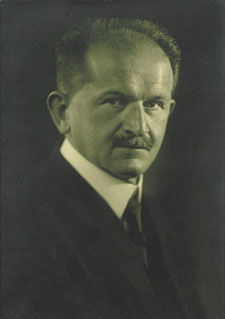Church Government: “Moderate” Confessing Church
The Bavarian regional church had repulsed the German Christians’ claims to power in the Kirchenkampf of 1933-34 and thus preserved its confession, constitution and legitimate church government. It was therefore considered to be “intact” in the usage of the day. In addition, it had taken the side of the Confessing Church, been involved in its governing bodies and attended the confessional synods. The regional church continued to remain “intact” from 1935 to 1939. Then, the church government, pastors and parishes’ struggle was directed at the Nazi state’s more and more open anti-church and anti-Christian policies rather than at the German Christians.
The church government under Regional Bishop Hans Meiser (1881–1956) protested in numerous petitions and communiqués against the elimination of denominational schools, the restrictions on the church’s youth work, the exclusion of the church from the media, the disparagement of the Old Testament and the general defamation of Christianity by Nazi propaganda. It refused to implement anti-church government directives and demonstrated its solidarity with other members of the Confessing Church by providing aid to persecuted churches. Regional Bishop Meiser fended off the Reich Ministry of Church Affairs’ attempts to bring the regional church under control in the fall of 1935 by appointing a church committee.
Just like the governments of the other intact regional churches, the Bavarian church government was willing, however, to accept the state’s appointment of church committees in the Reich Church and in the destroyed regional churches. Since the Councils of Brethren in the destroyed regional churches rejected church committees categorically, it thus contributed to the Confessing Church’s split. The Confessing Church therefore split organizationally, too, in February of 1936: Vying with the (Second) Provisional Church Government, which had just been elected by the Councils of Brethren, the Lutheran bishops of intact regional churches under Bavaria’s leadership gave themselves a government of their own with the so-called Luther Council. This weakened the Confessing Church lastingly.
Although the Luther Council considered itself to be part of the Confessing Church, it rejected full communion with the Councils of Brethren out of fear of a union with the Reformed and United Churches and planned to establish a Lutheran Church in Germany. Since it proved to be more willing to compromise toward Nazi church policy than the Councils of Brethren, it was regarded as “moderate”. Thomas Breit (1880–1966), a member of the Bavarian high consistory, took over its chairmanship. He had already realized that Christianity and Nazi ideology were irreconcilable before 1933 and was a member of the joint government of the Confessing Church until its split. As chairman of the Luther Council, he played a role in the formation of individual action coalitions with the Provisional Church Government despite the split.
The Luther Council’s protests directed at the state and party’s ecclesio-political measures were significantly weaker than those of the Councils of Brethren. The Provisional Church Government’s additional criticism of the Gestapo, concentration camps and anti-Semitism in its famous memorandum to Hitler on Nazi church policy of 1936 caused a serious rift with the Luther Council. The trenches between the “moderate” and the “radical” wings of the Confessing Church deepened in the fall of 1938 when, under political pressure, Meiser and other “moderate” church leaders distanced themselves publicly from the Provisional Church Government because of its “liturgy of prayer on the occasion of impending war”.
Despite its “moderate” course, the Bavarian church government and Regional Bishop Hans Meiser in particular were considered the Nazi regime to be just as much enemies of the state as the “radical” Councils of Brethren in the destroyed regional churches. Nothing changed this, not even the Bavarian church government refusal to publicly protest the Nazi state’s political measures. It remained silent, especially about the ostracism and disenfranchisement of Jewish fellow citizens by the Nuremberg Laws in 1935 and about the crimes of the November Pogrom 1938, which had been committed quite openly in public. It supported the work of Pastor Grüber’s Office with notable amounts of money, though, and even established aid agencies for racially persecuted Christians in Munich and Nuremberg.
The church government’s course entailing compromises, its conflicting relationship with the “radical” Confessing Church, its confession-driven involvement in the Luther Council and its silence about Nazi racial policy provoked opposition among a minority of Bavarian pastors and laity. Some clergy, such as Karl Steinbauer or Walter Hildmann, stood up to the Nazi regime more resolutely and courageously than the church government, which frequently viewed them as malcontents who were endangering themselves and the regional church unnecessarily. Individual laypersons, such as the church councilmen in Seeshaupt, showed great courage during the November Pogrom 1938. Ultimately, a layperson, Wilhelm Freiherr von Pechmann, demanded that the church government protest publicly against the persecution of Jews but his appeals were to no avail.
Source / title
- © Landeskirchliches Archiv Nürnberg, Bi 6 Nr. 205

